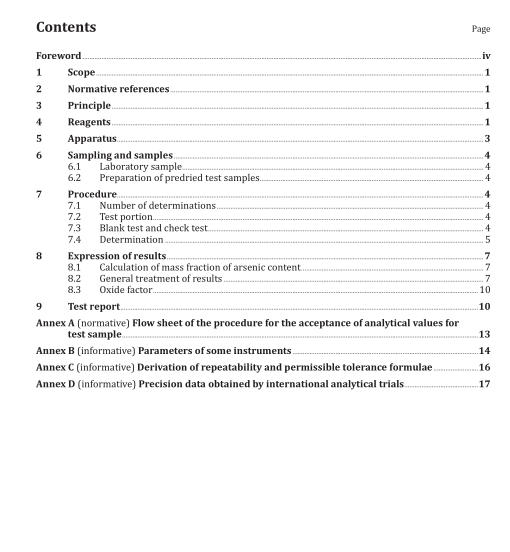BS ISO 17992:2013 pdf download.Iron ores — Determination of arsenic content — Hydride generation atomic absorption spectrometric method
4.18 Arsenic standard solution B. I pg/mi,
Transfer 10 ml of arsenic standard solution A 4J.Z) to a 1 I volumetric flask, dilute to the mark with water, and mix.
1 ml of standard arsenic solution B contains 1 pg of arsenic.
4.19 Arsenic standard solution C. 0.1 pg/mI.
Transfer 10 ml olarsenic standard solution B (4J.Ii) to a 100 ml volumetric [task, dilute to the mark with water, and mix.
I ml of standard arsenic solution C contains 0,1 pg of arsenic.
4.20 Methyl orange, Indicator.
4.21 Methyl orange solution. 1 mg/mI.
Dissolve 0,10 g of methyl orange in 20 ml of water. Dilute to 100 ml.
5 Apparatus
Use ordinary laboratory apparatus, including one-mark pipettes and one-mark volumetric flasks complying with the specifications of ISO 648 and ISO 1042 respectIvely, and the following.
5.1 Atomic absorption spectrometer, equipped with an arsenic hollow cathode lamp or electrodeless discharge lamp.
WARNING — Follow the manufacturer’s Instructions to avoid possible explosion hazards for
IgnIting and extInguishIng the air-acetylene flame and possible burning for hot electrIc furnace.
Wear tinted safety glasses whenever the atomic absorption spectrometer is in operation. Good
ventilation ol the flame Is necessary to prevent poison by arsenic hydride.
The atomic absorption spectrometer used In this method shall meet the following criteria,
a) Minimum sensitivity: The absorbance of the highest concentration calibration solution (see 7,4.3) is at least 0,25.
b) Graph linearity: The slope of the calibration graph covering the top 20% of the concentration range (expressed as a change in absarhance) is not less than 0,7 of the value of the slope for the bottom 20% of the concentration range determined in the same way.
c) Minimum stability: The standard deviation of the absorbance of the most concentrated calibration solution and that of the zero calibration solution, each being calculated from a sufficient number of repetitive measurements, are less than 1,5 % and 0,5 %, respectively, of the mean value of the absorbance of the most concentrated solution.
The use of a strip-chart recorder and/or digital readout device is recommended to evaluate criteria a), b), and c and for all subsequent measurements.
Parameters will vary with each instrument. The parameters In Annex B were successfully used In several laboratories and they can be used as guidelines. An air-acetylene flame or electric furnace capable of reaching temperatures of 900°C to 1 000°C is used.
5.2 Hydride generator. continuous or discontinuous injection sample hydride generator.
An example of continuous Injection sample hydride generator Is given in Figure Land an example of discontinuous injection sample hydride generator is given in Figure 2.
5.3 Quartz tube atomizer (T type).
An example of a quartz tube atomizer is given in Figure 3.
5.4 Muffle furnace.
5.5 Zirconium crucible, of minimum capacity 25 ml.
5.6 Pipettes.
5.7 Volumetric flasks and storage bottles.
5.8 Carrier gas supply, inert gas.
6 Sampling and samples
6.1 Laboratory sample
For analysis, use a laboratory sample of —100 urn particle size that has been taken and prepared in accordance with 150 3082. In the case of ores containing significant contents of combined water or oxidizable compounds, use a particle size of —160 pm.
NOTE A guideline on significant contents of combined water and oxidizable compounds is incorporated in
ISO 7764
6.2 Preparation of predried test samples
Thoroughly mix the laboratory sample arid, taking multiple increments, extract a test sample in such a
way that It Is representative of the whole contents of the container. Dry the test sample at (105 ± 2) °C
as specified In ISO 7764, (ThIs Is the predried test sample.)
7 Procedure
7.1 Number of determinations
Carry out the analysis at least in duplicate in accordance with Annex A. independently. on one predried test sample.
N0TF The expression “independently’ rne.ns that the second arid any subsequent result is nut 1fected by the previous result(s). For this partlcubr analytical method, this condition Implies that the repetition of the procedure is carried out either by the same operator at a different tlrn or by a different operator Including. In either case, appropriate recalibratlon.
7.2 Test portion
Taking several increments, weigh, to the nearest 0,000 1 g. approximately 0.5 g at’ the predried test sample obtained in accordance with 62.
7.3 Blank test and check test
In each run, one blank test and one analysis of a certified reference material of the same type of ore shall be carried out parallel with the analysis oIthe ore sample(s) under the same conditions. A predreed test sample of the certified reference material shall be prepared as specified In 6.2.
Where the analysis is carried out on several samples at the same time, the blank value can be represented by one test, provided that the procedure is the same and the reagents used are from the same reagent bottles.BS ISO 17992 pdf download.ISO 17992-2013 pdf download
